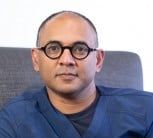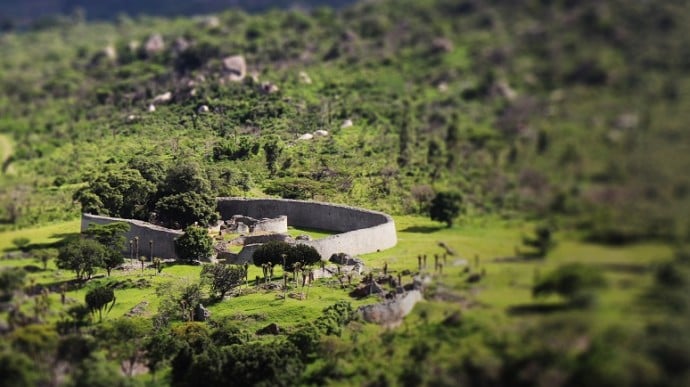Paediatric neurosurgeon Professor Llewellyn Padayachy, Head of the Department of Neurosurgery at the University of Pretoria’s (UP) Steve Biko Academic Hospital, is redefining how brain-related diseases are diagnosed and treated, especially in low-resource settings. He’s at the forefront of pioneering work in non-invasive techniques to assess and measure raised pressure inside the skull, known as intracranial pressure (ICP).
As part of his PhD 15 years ago, Prof Padayachy set out to find safer methods for earlier diagnosis of brain tumours in children, a patient group that often presented far too late, with tumours already dangerously large. This trend of delayed diagnosis shifted his research focus to detecting raised ICP, pressure within the skull – a critical marker when diagnosing life-threatening neurological conditions. Traditionally, assessing this pressure involves invasive procedures and highly specialised equipment, resources that are often unavailable in rural or primary care settings.
“Ultimately, this non-invasive system offers a ‘thermometer for the brain’ – a simple yet powerful diagnostic tool that enables earlier treatment, better outcomes and more equitable healthcare access,” Prof Padayachy explains. “This research provides a lifesaving bridge between innovation and accessibility, especially on a continent where neurosurgery is severely under-resourced.”
At the heart of this innovation is the concept of the eye as a window to the brain. Initially using ultrasound imaging to measure the optic nerve sheath – along with technologies like optical coherence tomography (which uses light waves to take cross-sectional images of eye tissue), intraocular tonometry (to measure pressure inside the eye) and retinal scanning – his team has refined methods for non-invasively assessing ICP, without radiation or surgical intervention. This offers a faster, safer and more portable method for diagnosing neurological diseases.
Prof Padayachy’s initial work has since expanded to include adult patients, and now plays a crucial role in identifying a range of central nervous system disorders, including brain tumours, hydrocephalus, infections and intracranial bleeding, conditions where early detection is essential for effective treatment.
This non-invasive approach has major benefits for both patients and health systems.
Early detection of conditions like brain tumours and hydrocephalus allows for intervention when symptoms are still mild and treatment is most effective. Detecting tumours earlier is the best modifier of outcome.
This eye-based technique is designed for point-of-care diagnosis. It is a simple, rapid method that can be employed in GP practices, rural clinics or by assistant nurse, with minimal training. By analysing high volumes of data using machine-learning algorithms, a “traffic light” system has been developed to streamline diagnosis: green for normal, orange for uncertain and red for urgent intervention.
The reduced risk and cost of this approach eliminates the dangers of invasive testing and reliance on expensive imaging tools like magnetic resonance imaging (MRI) and computed tomography (CT) scans, which are often unavailable in rural areas.
It can support broader disease management by aiding in the diagnosis of not just tumours but various central nervous system disorders, including bleeds, infection, strokes and traumatic brain injuries. This technology is also being tested in countries like Norway and Germany, and is applicable to astronauts who experience raised intracranial pressure in microgravity.
According to the World Health Organisation (WHO), more than two billion people around the world lack access to safe surgical care, with low- and middle-income countries carrying the greatest burden. Africa faces immense challenges in neurosurgery, such as severe underfunding, a lack of training positions and a high burden of disease. There is one neurosurgeon per four million people, far below the WHO’s recommendation of one per 200 000. This shortage, compounded by the lack of a central brain tumour registry and limited access to diagnostics, severely impacts patient outcomes.
In South Africa alone, limited infrastructure and only a handful of neurosurgical training posts mean that even the brightest medical talent can be lost in the system.
“We have more than 70 applicants for a single registrar training post,” Prof Padayachy says. “This is completely inadequate. This research demonstrates how innovation born out of necessity can help us overcome these hurdles.”
This non-invasive technique isn’t just capable of transforming care in Africa; its application in diagnosing visual impairment due to raised intracranial pressure in astronauts, where a conventional tool like lumbar puncture is difficult to use, highlights its versatility. Ultrasound, which is portable and radiation-free, is the only imaging modality suitable for space. The same “thermometer for the brain” now being tested in orbit began in the clinics of South Africa.
“With the right support, we can create a self-sustaining model for research in Africa, by Africans,” Prof Padayachy says. “We certainly have the talent, and we can develop the tools to lead the world in non-invasive brain diagnostics.”
Click on the infographic in the sidebar to learn more.
Professor Llewellyn Padayachy
November 19, 2025

Professor Llewellyn Padayachy completed his undergraduate studies at the University of Pretoria (UP) and a postgraduate degree at the University of Cape Town. He was a postdoctoral fellow at the University of Oxford in the UK, and undertook visiting fellowships and a professorship at the Carlo Besta Neurological Institute, University of Milan; Baylor Medical College; and Eberhard Karls University of Tübingen.
He also paid short academic visits to the Neurosciences Institute, Stanford University; Boston Children’s Hospital, Harvard University; and Great Ormond Street Hospital for Children, University College of London.
In 2019, Prof Padayachy joined UP, where he says he found world-class infrastructure and support, adding that the research priorities of the Department of Neurosurgery are well aligned with the goals in the Faculty of Health Sciences. He leads the Brain Tumour and Translational Neuroscience Centre (BTC@UP). The centre’s research has a strong focus on early point-of-care diagnosis, and the improved surgical care of adults and children with brain tumours.
He states his field of research would contribute to the betterment of the world because early diagnosis is the best predictor of improved survival among brain tumour patients.
“That is why we have a strong research focus on developing and testing point-of-care diagnostic modalities,” Prof Padayachy says. “We have also refined our surgical technique and intra-operative use of adjuncts to provide the best neurosurgical care available.“
The Brain Tumour and Translational Neuroscience Centre has strong transdisciplinary and cross-faculty research collaborations with UP’s Departments of Physiology, Anatomy, Engineering, Paediatrics, Neurorehabilitation, Radiology, Nuclear Medicine, and Neurology.
A recent highlight of the centre’s research was the use of a novel mobile optical coherence tomography (OCT) scanner that collects and analyses images at bedsides. Prof Padayachy says they also have developed the Safe Neurosurgery Initiative to optimise intra-operative surgical capability, taking a structural, functional monitoring approach to maximise safe resection for children and adults with brain tumours.
“We have improved our capacity in the neuro-critical care and neuro-rehabilitation phases of treatment, and have exciting international collaborative research projects in these areas,” he says
As for what inspires Prof Padayachy in his research, he says he’s drawn inspiration from various events and sources over the years.
“The little patients we treat have always provided a sobering reality; it is no less than an absolute privilege to be entrusted with the care of these children,” he says. “The Japanese principle of kintsukuroi [a Japanese art form that uses seams of gold leaf to mend broken pieces of pottery, making them more valuable] is perhaps no more relevant than when we care for sick children – we would like them to feel better because of the care we have given them, in spite of being ‘broken’.
“When it comes to people, every good and decent thing I’ve learnt has been from the incredible foundation that was inspired by my grandparents at a very young age, and by my mother ever since. I’ve always been guided by a profound sense of spirituality and integrity.”
Prof Padayachy’s academic role model is the late Prof James Goodrich, who’s based in the Bronx in New York.
“Apart from being among the world’s best paediatric neurosurgeons, he was an exceptionally warm, compassionate human being, with a quirky passion for rare books, pens and art, an obsession that I happen to share. He guided not just my surgical skill, but also my thought pathway and career in neurosurgery.”
Prof Padayachy hopes to make a small but meaningful difference in the lives of children with brain tumours. He says his research matters because it may have wider relevance: while it started out with the aim of diagnosing raised intracranial pressure among children with brain tumours early, it may also be used for diagnosing raised intracranial pressure in astronauts in microgravity environments.
He offers the following advice to school learners or undergraduates who are interested in his field: “The fact that you must do it and do it to the best of your ability is incredibly important – slightly paraphrased from the great Mahatma Gandhi.”
He loves spending his free time with his daughters, whom he calls his “source of inspiration and joy in everything”.
 Story
Story
This edition is curated around the concept of One Health, in which the University of Pretoria plays a leading role globally, and is based on our research expertise in the various disciplines across healthcare for people, the environment and animals.
 Story
Story
Highly sophisticated water management techniques of ancient civilisations demonstrate the ingenuity of inhabitants who lived with limited water. It appears we need to look to the past to ensure a stable water supply in the future.
 Story
Story
A new study by researchers at the University of Pretoria (UP) and the University of Adelaide in Australia has revealed the real function of the giraffe’s long legs ¬– to reduce blood pressure.
Copyright © University of Pretoria 2025. All rights reserved.
Get Social With Us
Download the UP Mobile App